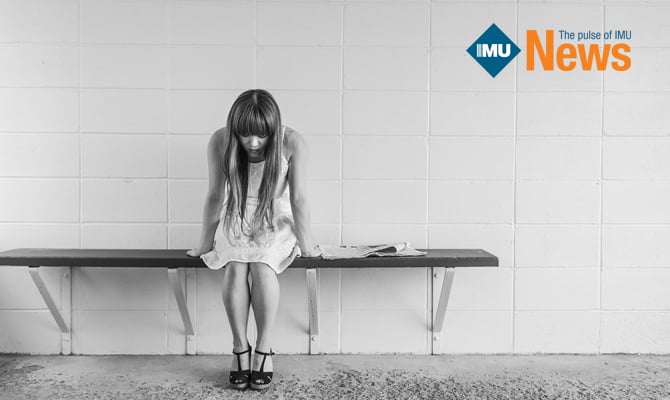No one chooses it. No one deserves it. It runs in families, it ruins families. Depression is not an emotion. Depression has no cause. Too often depression is conflated with sadness or anxiety. It is often treated as a taboo subject. It is like dropping a D-bomb in a conversation. How prevalent is depression? Table 1. studies on Prevalence of Depression in Malaysia
| Population |
No of Studies Reviewed |
Prevalence Rate (%) |
| Primary Care |
3 |
6.7-14.4 |
| Clinical |
5 |
3.9-46 |
| General Community |
5 |
6.3-18 |
Table 1 is the results extracted and summarized from a review titled ‘A Review on the Prevalence of Depression in Malaysia’ by Fidaus Mukhtar. A total of 13 studies were reviewed to find out the prevalence of depression in Malaysia. Overall, the depression prevalence rate in Malaysia ranged between 3.9 to 46%. Hence, it is important to recognise and take depressive symptoms seriously as depression affects the quality of life and increases the morbidity as well as mortality. Three big categories of depression Adolescent Depression
| What is adolescent depression? |
| It is more common to be recognised as teenage depression, this emotional disorder does not differ much from adult depression. Symptoms manifest in teens in various ways due to social and development challenges which include peer pressure, fluctuating hormone levels and puberty physical changes. |
| Why is it important to address depression early? |
| As depression is associated with high levels of stress and anxiety, an adolescent’s quality of life can be affected regardless of their personal, school or family life. More importantly, there is an increased risk of morbidity caused by suicide, caused by depression. |
| How to spot depression in teenagers? |
| There is estimated around 15 percent of children and adolescents from a study in American Family Physician presented with symptoms of depression. Although the symptoms can be difficult to be noticed and often confused with boredom, it is just more than that. |
| What are the symptoms to look out for? |
| • Changes in weight or appetite • Decreased interest in once used to be pleasurable activities • Appearing sad, irritable and tearful • Decrease in energy • Difficulty in concentrating • Feelings of guilt, worthlessness, or helplessness |
• Major changes in sleeping habits • Regular complaints of boredom • Talk of suicide • Withdrawal from friends or after-school activities • Worsening school performance |
|
|
| What are the causes of adolescent depression? |
| There is no single known cause but there is multiple factors including differences in the brain, traumatic early life events, inherited traits and learned patterns of negative thinking. |
| How is adolescent depression diagnosed? |
In Diagnostic and Statistical Manual of Mental Disorders (DSM), to be diagnosed with major depressive disorder, adolescents must have two or more major depressive episodes for at least two weeks. Their episodes must involve at least five of the following symptoms:
| • Agitation or psychomotor retardation noticed by others • A depressed mood most of the day • A diminished ability to think or concentrate • A diminished interest in most or all activities • Fatigue |
• Feelings of worthlessness or excessive guilt • Insomnia or excessive sleeping • Recurring thoughts of death • Significant unintentional weight loss or gain |
|
|
| What are the treatments available? |
| Finding the right treatment requires patience as to determine which works best. Among the medications available are Selective Serotonin Reuptake Inhibitors (SSRIs), Selective Serotonin and Norepinephrine Reuptake Inhibitors (SNRIs), Tricyclic Antidepressants (TCAs) and Monoamine Oxidase Inhibitors (MAOIs). Psychotherapy also works in much different behavior. Exercise, sleep and a balanced diet are mandatory to achieve good results. |
Postpartum Depression
| What is postpartum blues? |
| The mood changes occurring after delivery is known as postpartum blues or baby blues. This is a fairly common problem among the woman as they undergo hormonal changes during pregnancy. |
| What causes it? |
| After childbirth, there will be a drop in the oestrogen and progesterone level along with fluctuations in blood pressure, immune functioning and metabolism. It has been deduced that these changes and imbalances contribute to the development of baby blues. |
| How long does it last? |
| This might last from a few days up to 2 weeks. However, if this condition becomes severe – interfering with the woman’s function – and lasts longer than 6 months, it is called postpartum depression (PPD). About 10-15% of all women suffer from PPD. |
| Who is at higher risk of developing PPD? |
| Biological |
Social |
Psychological |
- History of miscarriage within 6 months
- History of serious illness or previous depression
- History of severe PMS or premenstrual dysphoric disorder
- Difficult delivery, prenatal problems, premature birth
|
- Unplanned pregnancy
- Lower educational level
- Financial problem
- Poor family relationship
- Work stress
- Non-breastfeeding
|
- Difficulty losing the baby weight
- Insecurity regarding physical and sexual attractiveness
- First time mothers
- Sleep deprivation
- Anxious about proper care of baby
|
|
| Recognising the signs and symptoms of PPD and its importance |
It is crucial to identify the signs and symptoms of PPD at the early stage as most mothers remain undiagnosed and this increases the prevalence of postpartum psychosis. Postpartum psychosis is a medical emergency due to the risk of suicide and infanticide. The first 6 months after childbirth is also the most important time for the mother and baby to bond. Studies have shown that a baby without adequate attention from the mother is bound to develop delayed cognitive and development skills and inferiority complex. The signs and symptoms are as following:
| • Depressed mood • Crying spells • Difficulty bonding with the baby • Withdrawn from society • Change in appetite • Change in sleep pattern • Fatigue |
• Irritability • Reduced interest in activities they used to enjoy • Feeling of worthlessness • Fear of not being a good mother • Poor concentration • Thought of self-harm or harming the baby • Recurrent thought of death or suicide |
|
|
| Assessment tools used for the measurement of depression |
| • Edinburgh Postnatal Depression Scale • Postpartum Depression Screening Scale • Beck Depression Inventory • Depression, Anxiety and Stress Scale • Patient Health Questionnaire • Hospital Anxiety Depression Scale |
| Management |
| 1. Pharmacotherapy • Antidepressants – SSRI (4 weeks for acute phase till remission, 6-9 months for continuation phase, 2 years maintenance phase 2. Psychotherapy • Cognitive and behavioral therapy – this focuses on the mood, thoughts and actions to help patients address current issues and symptoms • Interpersonal psychotherapy – weekly session focusing on what is happening in the present • Couple therapy • Group therapy 3. Electroconvulsive therapy 4. Self-care strategies • A good support system • Physical activity 3 times per week for 30 minutes • Stress management • Good quality sleep • Balanced diet |
Depression in Geriatric Age Group
| About Geriatric Depression |
| Geriatric depression is depression that involves the elderly age group which is not a normal part of aging. |
| How common is it? |
| There is significant proportion of older people that experience depression. However, they are regularly left untreated and undiagnosed. This is because depression in the elderly age group is frequently mistaken for the consequence of various diseases or side effects of medication. In addition, an elderly patient tends to have more atypical manifestation of the illness and do not exhibit with depressed mood but instead present with atypical symptoms such as insomnia, anorexia, and fatigue. |
| Is it serious? |
| The delay in the diagnosis may lead to more significant consequences that include increased risk of mortality from an underlying illness or suicide. The death from an illness is mainly because depressed people are less compliant to their medication which will in turn worsen their medical condition. |
| Are there any risk factors? |
There are many factors that predispose an elderly person from developing a depression. This includes a history of:
| • Depression • Underlying medical conditions • Female gender • Unmarried |
• Recently divorced • Brain pathologies • Medications • Traumatic life events |
|
|
| What are the causes? |
| There are many causes that could lead to depression. It can largely be classified into biological and psychosocial. 1. Biological aspect • Underlying medical conditions that include higher rates of cognitive impairment, cerebral atrophy, enlarged ventricles and deep white-matter changes. 2. Psychosocial aspect • Type of personality of the individual • Different life stressors • Lack of a good support system |
| Evaluation of depression |
| Evaluation can be done using different scales which includes Beck Depression Inventory and Geriatric Depression Scale |
| Treatment available |
| There are many ways to treat an elderly patient who suffer from depression. They are mainly given antidepressants such as selective serotonin re-uptake inhibitors (SSRI) or Tricyclic antidepressants (TCA). In addition, they can also be given psychosocial therapy such as patient education, counseling, family therapy and many more. |
Prepared by: International Medical University Semester 8 medical students : Bhagya Mendis Abeysekera, Chin Yuen Quan, Hanusyia Subramaniam, Junaidah bte Mubarak Ali and Leong Kai Chung. Advisor: Dr Kavitha Nagandla, Senior Lecturer References: 1. Junaidah Murbarak Ali. Depression is Not an Emotion. The Malaysian Medical Gazette. Sep 2014. 2. Adolescent Depression [Internet]. Healthline. 2016 [cited 25 August 2016]. 3. Depression In Teens [Internet]. Mental Health America. 2016 [cited 25 August 2016]. 4. Postpartum depression facts. NIMH. Available from: 5. Thurgood S, Avery DM, Williamson L. Postpartum depression. American Journal of Clinical Medicine. 2009; 6(2). 6. Stewart DE, Robertson E, Dennis CL, Grace SL, Wallington T. Postpartum depression: Literature Review of Risk Factors and Interventions. University Health Network. Oct 2003. 7. Screening for Perinatal Depression. ACOG. May 2015. 8. Baby blues. Malaysian Psychiatric Association. 3 Sept 2009. 9. Rushidi WM, Shariff S, Yaacob MJ. Postpartum Depression: a Survey of the Incidence and Associated Risk Factors among Malay Woman in Beris Kubor Besar, Bachok, Kelantan. Malaysian Journal of Medical Sciences. Jan 2002; 9(1):41-48. 10. Birrer RB, Vemuri SP. Depression in Later Life: A Diagnostic and Therapeutic Challenge. Am Fam Physician. 2004[CITED 15 May 2004];69(10):2375-2382. 11. Aziz R, Steffens DC. What Are the Causes of Late-Life Depression?. Psychiatr Clin North Am. 2013 [CITED Dec 2013]; 36(4): 497–516.








